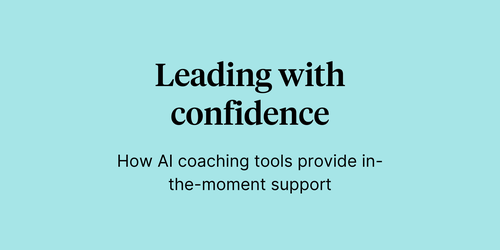
Article

When leaders see the results of an employee engagement survey, they’re often motivated to take action. So why doesn’t the Culture Amp platform allow companies to select an engagement item as a focus area for building actions? Because in order to take meaningful action, you’ll first need to explore what drives engagement at your organization.
Employee engagement is a psychological outcome, meaning that it’s a result of other inputs. Compensation, work-life balance, manager satisfaction, and other factors shape your employees' opinions of your business and affect their engagement levels.
Using surveys to measure engagement provides a helpful overview, but it’s hard to create an action plan when all you have to go off of is, “Our engagement is down.” Instead, companies must identify which workplace factors are driving engagement and work to improve any barriers to better engagement. Once you address these key drivers, higher engagement will follow.
In this article, we’ll discuss the common misconception about acting on employee engagement results, the two types of survey questions to ask for better insights, and how to take effective action on survey findings.
So many different factors influence employee engagement in an organization, but oftentimes, engagement surveys only give a surface-level view of how employees perceive these factors. For example, when a company asks employees to respond to the statement, "I am proud to work for [Company]," respondents have a limited number of options to choose from: strongly agree, agree, neither agree nor disagree, disagree, or strongly disagree.
This doesn’t leave much room for nuance, especially for a topic as subjective and personal as pride. Pride is a hard emotion to capture in one question, as it can be influenced by a variety of factors, like:
If the majority of employees disagree with the “pride” statement, and the organization decides it wants to focus on improving employee pride in the next year based on their responses, it doesn’t have much to go on. After all, what actions can you take to influence someone's pride? Do they need a new boss? Do they need more information about the company's goals? What exactly will make them proud to work for this business?
Clearly, the company doesn’t have enough information to build an action plan. But that doesn’t mean the question isn’t useful. By asking additional survey questions alongside this pride inquiry, your business can learn what actions to take to influence people's pride and improve their sentiment towards your organization. We’ll explain more below.
At Culture Amp, we believe understanding employee engagement takes more than one question. In fact, we think it takes five.
We use an “engagement index” that combines five questions to measure different employee engagement outcomes. Together, these questions give a more multifaceted understanding of engagement as they represent the high-level feelings, attitudes, and behaviors that we'd ideally like our people to experience.
Here are the five engagement outcomes we urge brands to ask about in every engagement survey:
Again, these questions help us measure the engagement outcomes but fail to tell us which factors are causing these results. While insightful, these findings are nearly impossible to act upon directly. For that reason, they must be paired with driver or impact questions, which we’ll discuss below.
Once you have a general pulse on engagement within your organization, thanks to our engagement outcome questions, it’s time to explore the more tangible aspects of your workplace and culture to understand where you might want to focus your investments.
At Culture Amp, we use a standard employee engagement survey template containing 57 questions (don’t worry – it takes most people just under 10 minutes to complete), known as driver questions or impact questions. These questions measure employee engagement in detail and assess various contributing factors such as leadership, learning and development, social responsibility, feedback, and recognition.
Examples of engagement survey driver questions include:
Employee answers to these questions give you the context into the engagement areas you need to take action on to improve your workplace experience. For example, if you identify that questions about leadership and recognition are top drivers of engagement and you feel you have the resources and motivation to address them, you can create an action plan to improve these two areas. You may even discover if the two are interrelated, which is often the case.
Let's look at a specific example. Culture Amp once worked with a children's charity to help improve the company’s engagement scores. The company had scored low on work-life balance for many years, and investments in this area had not improved the organization’s culture and engagement. After running a driver analysis, we discovered that work-life balance wasn't a strong engagement driver at this organization. No matter how much it was improved, it wouldn't move the needle on engagement. Employees cared more passionately about other areas, namely, "spending resources efficiently.”
Think about it. Working for a children's charity, most employees cared deeply about seeing the company’s funds and resources spent improving the lives of the children they serve. The company’s mission and the efficient use of funds were the two factors that had the largest impact on employee engagement. By spending resources on work-life balance, the organization risked disengaging employees further as they’d prefer to see funds directed toward charity initiatives. Taking a step back to assess key engagement drivers helped the company identify the areas that truly mattered to employees, boosting engagement in the process.
While asking the right questions can improve engagement, so can the right survey solution. Culture Amp offers a variety of features that can help your business draw more powerful insights and devise a strong action plan. Here’s a brief look at some of our standout tools:
When paired together, engagement and driver survey questions give your team the information you need to create a meaningful action plan and drive real change within your organization. If you’re ready to conduct your engagement survey and incorporate driver analysis, Culture Amp is here to help. Learn how Culture Amp can help give you the tools you need to drive better engagement at your company.
